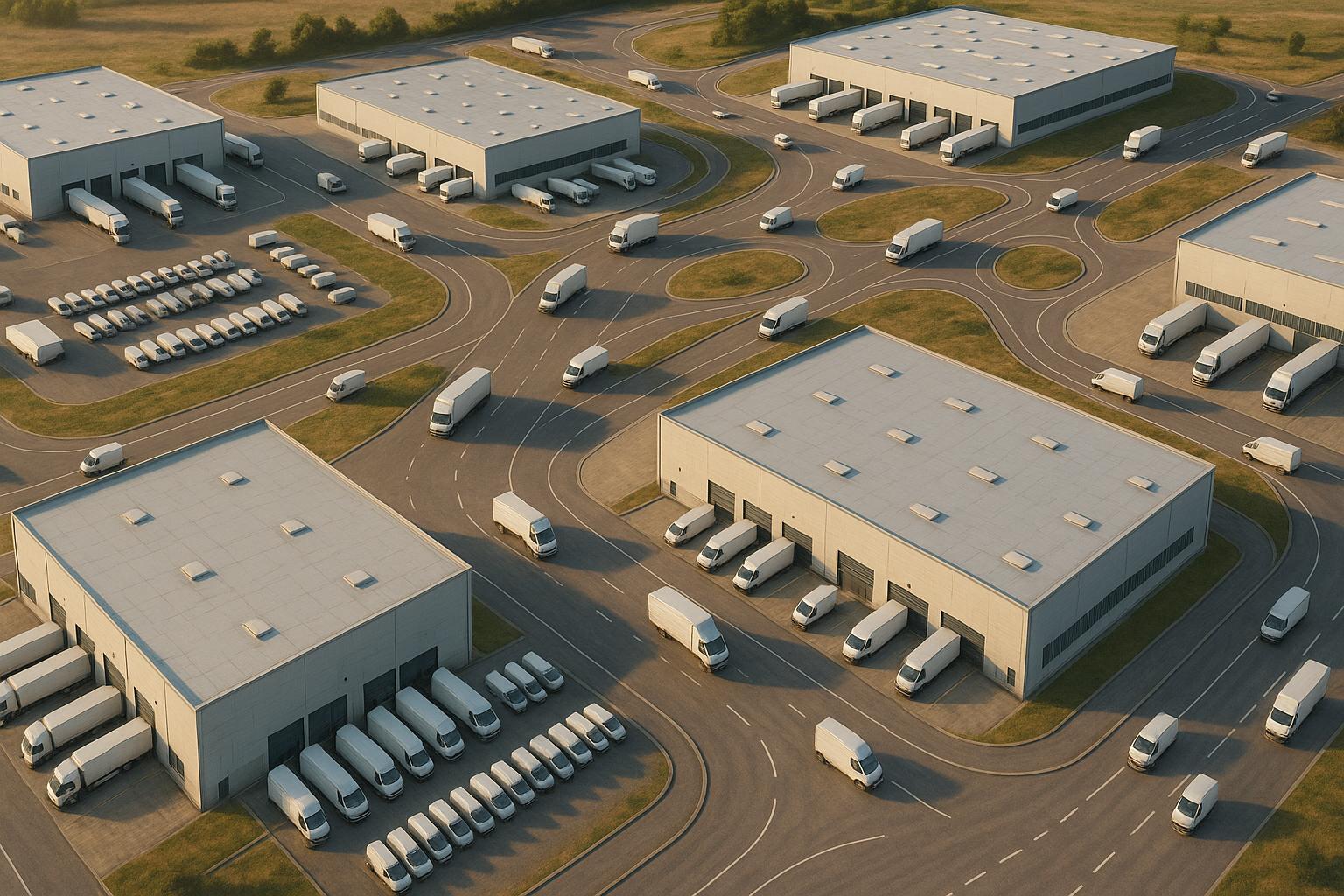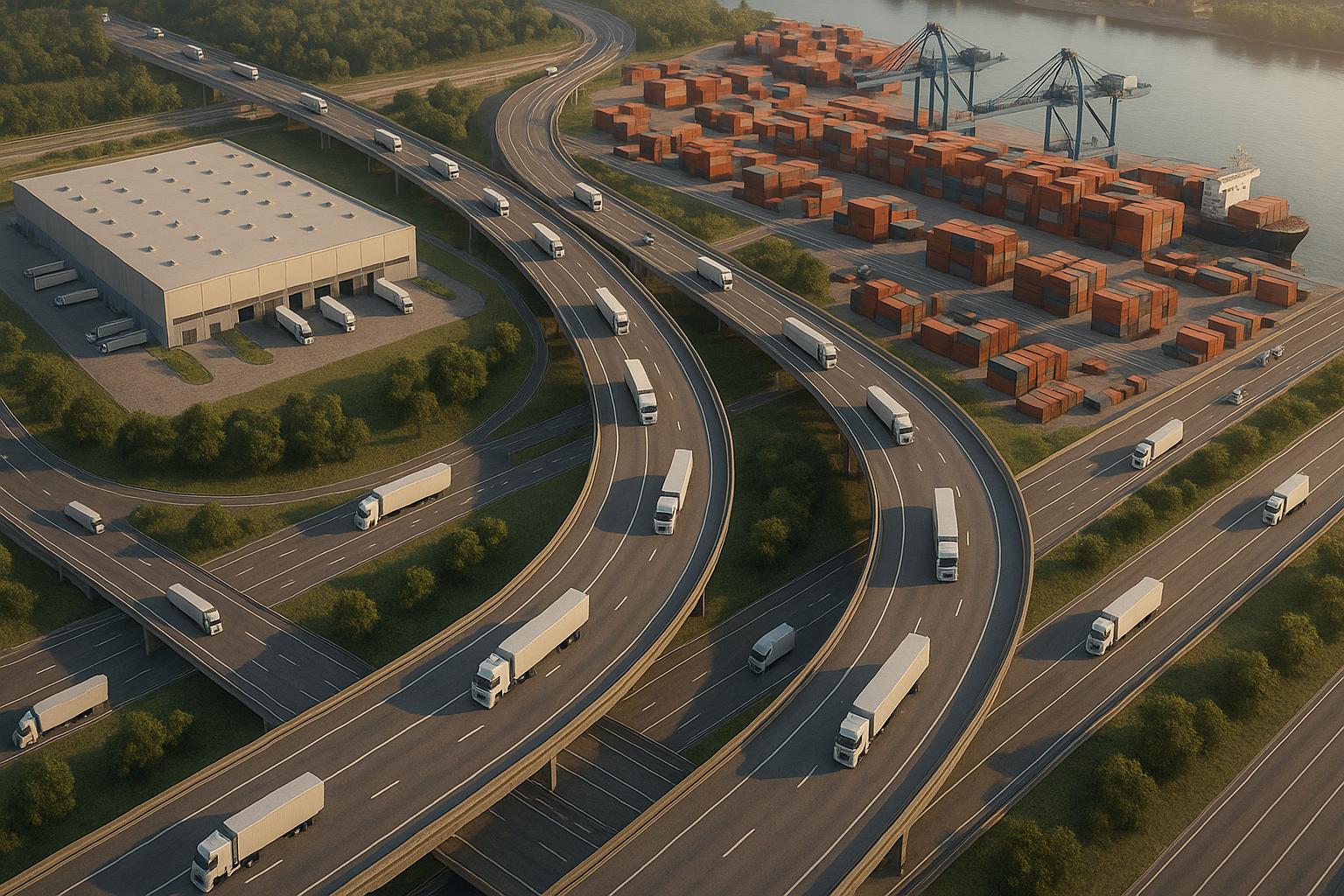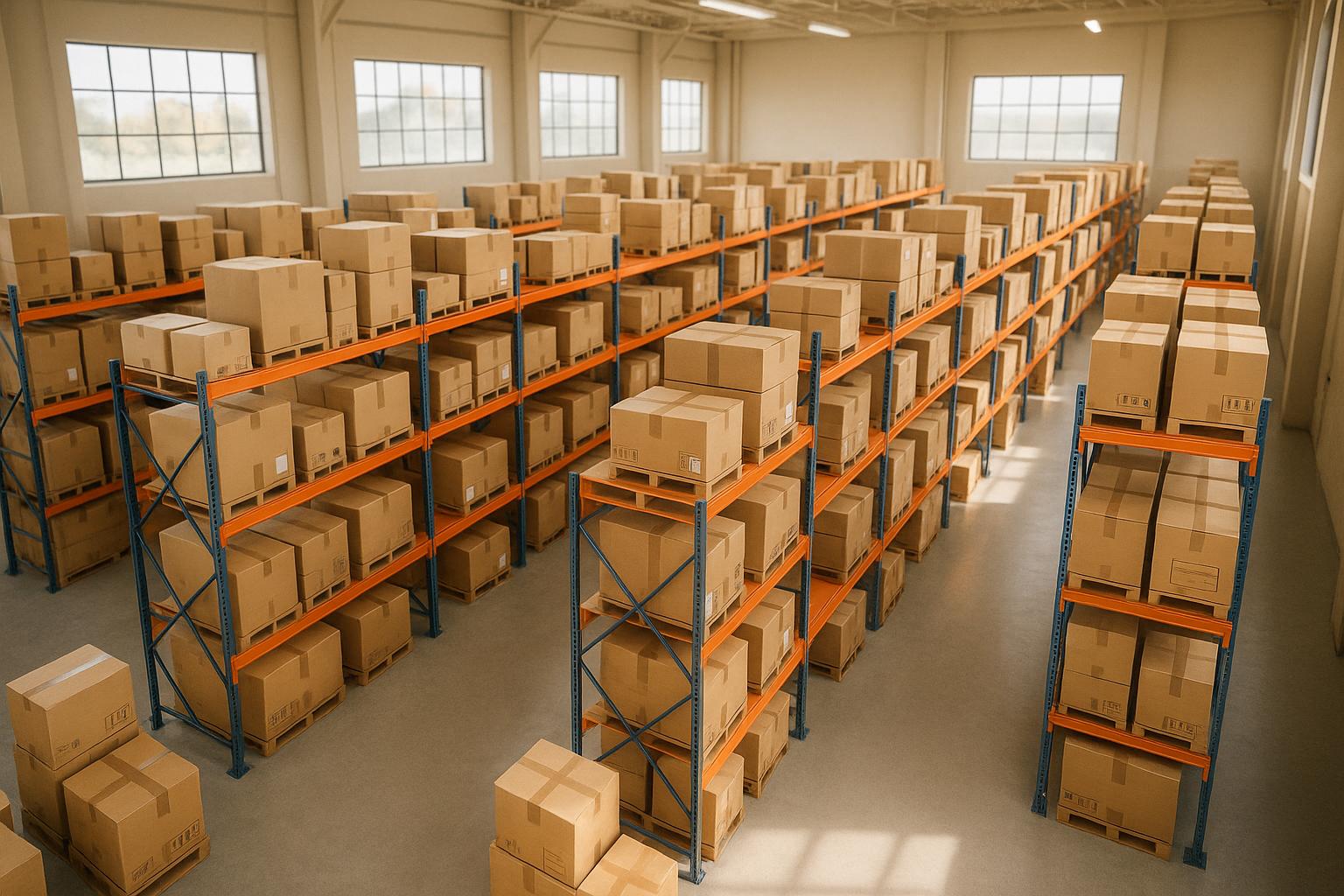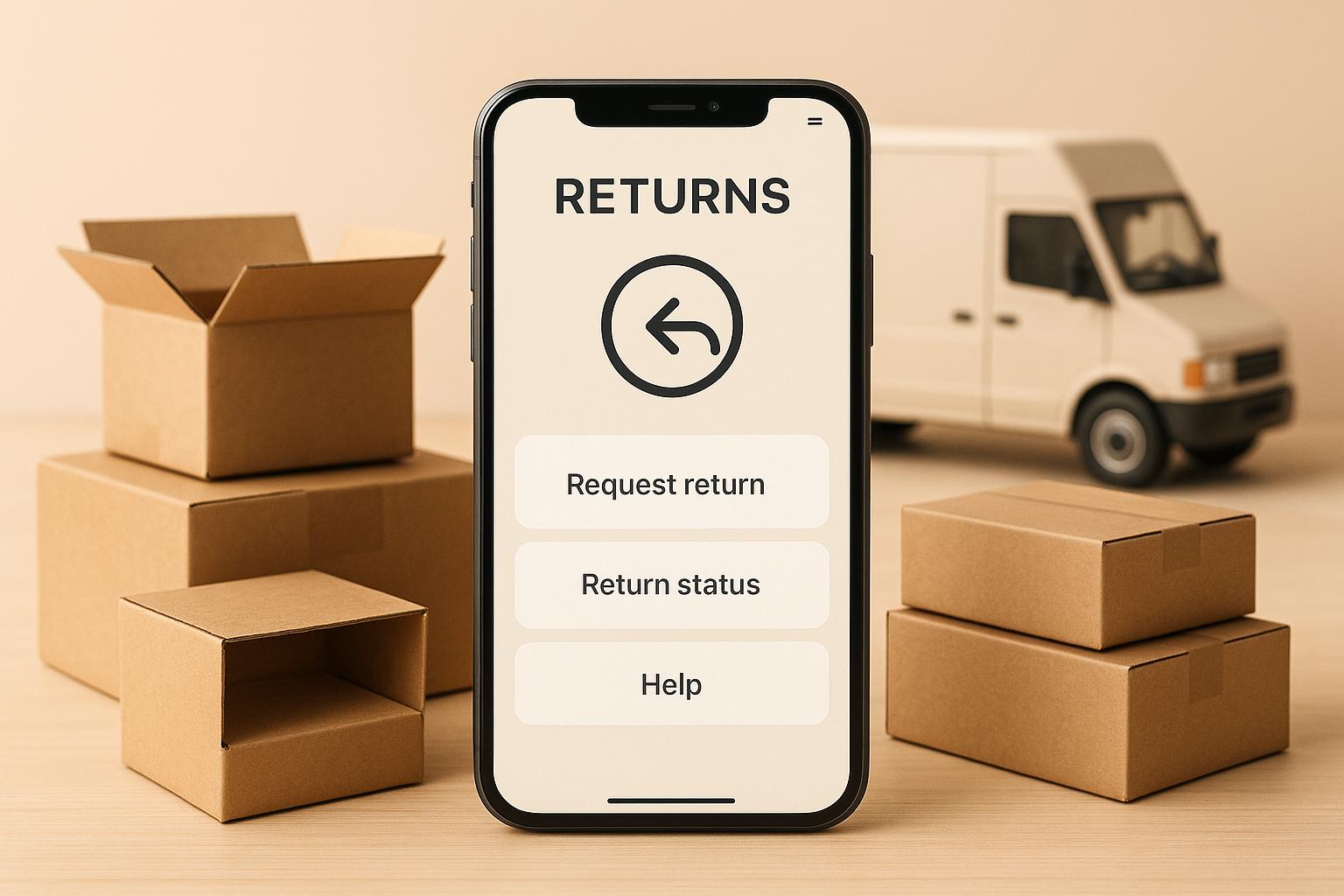How Scalable Supply Chains Support E-commerce Growth

Scalable supply chains are critical for e-commerce businesses to handle fluctuating demand, reduce costs, and improve delivery speed. As online sales grow, outdated systems often struggle with increased order volumes, leading to delays and dissatisfied customers. Scalable solutions solve this by using flexible logistics, advanced technology, and distributed fulfillment centers to ensure smooth operations during peak seasons and expansion efforts. Key benefits include:
- Faster Order Fulfillment: Businesses using scalable systems process orders up to 50% faster.
- Cost Savings: Optimized inventory and logistics can cut costs by up to 30%.
- Improved Customer Experience: Faster deliveries and accurate tracking increase satisfaction by 20–30%.
- Risk Management: Distributed networks and real-time tracking minimize disruptions.
Scaling your eCommerce business: A supply chain perspective
Key Benefits of Scalable Supply Chains for E-commerce
Shifting from traditional supply chain models to scalable systems isn't just about handling more orders - it’s about transforming how your business operates. These systems deliver measurable improvements that boost your bottom line and enhance customer satisfaction.
Better Operational Efficiency
Scalable supply chains bring automation, streamline processes, and enable real-time tracking, which reduces manual errors and speeds up order fulfillment. This goes far beyond what static systems can achieve.
E-commerce businesses using advanced supply chain solutions process orders up to 50% faster than those relying on manual or fragmented systems. Automation in tasks like picking and packing eliminates bottlenecks and minimizes errors. When orders move seamlessly from placement to shipment, customers receive their products faster and with fewer mistakes.
Real-time tracking offers visibility across your entire supply chain, helping you identify and address issues before they escalate. This allows for smarter decisions about inventory placement, routing, and resource allocation, resulting in a more responsive and efficient operation.
"In logistics, consistency is everything - and that's exactly what JIT delivers. Their transportation services are dependable, seamless, and backed by a team that truly understands our business needs. Working with JIT has made a tangible difference in our efficiency and customer satisfaction." - Armando Otiz, Manager 3pl/Inventory, exclusive networks
Collaborating with advanced logistics partners also brings expertise in material handling and ensures flexibility for last-minute requests. This adaptability keeps daily operations running smoothly while accommodating urgent customer needs, leading to cost savings and improved efficiency.
Cost Optimization
Scalable supply chains are a game-changer for reducing operational expenses, cutting costs by up to 30% through optimized inventory management and logistics. Advanced analytics help you avoid costly stockouts and overstock situations, while strategic inventory placement across multiple fulfillment centers lowers transportation expenses.
Consolidating shipments, negotiating better carrier rates, and optimizing delivery routes further reduce per-unit costs. Automation also trims down manual processing needs, and standardized procedures cut training costs and limit expensive errors.
"Add to that their competitive pricing and professional service, and it's clear why they're one of our most valued partners." - Curtis Martin, Senior Operations Manager, Synnex
This combination of cost efficiency and operational excellence not only saves money but also enhances customer satisfaction, creating a ripple effect that benefits your business as it grows.
Better Customer Experience
Scalable supply chains make superior service the norm. Businesses that provide accurate inventory data and real-time delivery tracking see customer satisfaction rates rise by 20-30%.
Strategically distributed inventory across multiple fulfillment centers enables faster deliveries, including same-day or next-day options, meeting the high expectations of modern shoppers. Real-time inventory updates across all sales channels ensure customers can confidently purchase what they see, avoiding the frustration of stockouts. Reliable order fulfillment - with on-time delivery, intact products, and accurate tracking - builds trust and loyalty.
"JIT sets the bar high in logistics. Their on-time performance, ability to handle last-minute requests, and expertise in material handling are game-changers for us." - Curtis Martin, Senior Operations Manager, Synnex
This dependability turns one-time buyers into repeat customers who trust your brand to deliver every time.
Risk Management and Flexibility
Scalable supply chains not only improve efficiency and reduce costs but also help manage risks and adapt to sudden changes. These systems are designed to handle market fluctuations, seasonal spikes, and unexpected disruptions without compromising service quality.
Distributed fulfillment networks add a layer of operational redundancy. If one location faces challenges like weather delays or labor shortages, orders can be rerouted to other fulfillment centers, minimizing delays.
Flexible capacity management allows you to scale operations up or down based on demand rather than rigid forecasts. During peak seasons, you can tap into additional warehouse space and transportation capacity without committing long-term.
Advanced forecasting and analytics provide early warnings about potential issues, such as shifts in demand or supplier performance. This proactive approach lets you make adjustments before problems arise, keeping your supply chain stable and responsive.
The ability to handle last-minute changes and urgent requests without disrupting daily operations is increasingly important to customers. This mix of risk management and flexibility ensures your supply chain remains resilient and adaptable, no matter what challenges come your way.
Strategies to Build a Scalable Supply Chain
A well-thought-out supply chain strategy can transform logistics from a potential stumbling block into a powerful tool for growth. By focusing on scalability, your e-commerce business can handle surges in demand without sacrificing service quality or efficiency.
Distributed Fulfillment Centers
Placing warehouses strategically across different regions is a game-changer for scalable supply chains. Instead of relying on a single location, distributed fulfillment centers bring your inventory closer to customers. This approach slashes delivery times and reduces transportation expenses.
For example, JIT Transportation has positioned warehouses across key U.S. regions, enabling 1–2 day delivery for most customers. By analyzing order data to pinpoint high-demand areas and choosing sites near major transportation hubs, you can minimize last-mile delivery distances and access multiple shipping carriers for better routing and pricing options.
Technology Integration
Integrating advanced technology into your supply chain is essential for scalability. Systems like Warehouse Management Systems (WMS), Transportation Management Systems (TMS), and real-time tracking not only automate workflow but also provide full visibility across operations.
- WMS: Optimizes storage layouts, automates picking processes, and manages inventory across multiple locations, reducing errors and speeding up fulfillment.
- TMS: Helps with carrier selection, route optimization, and freight management to ensure cost-effective shipping.
- Real-time tracking: Keeps you updated on inventory levels, order statuses, and shipment progress, enabling faster responses to any challenges.
As JIT Transportation puts it:
"With a strong network, smart technology, and a team that knows logistics inside and out, we make sure your shipments arrive on time, every time."
Cloud-based platforms further enhance efficiency by enabling seamless data exchange, cutting down on paperwork, and reducing errors. This creates a supply chain that can quickly adapt to changes in demand or unexpected disruptions.
Flexible Inventory Management
Managing inventory effectively is another cornerstone of a scalable supply chain. Using data-driven strategies, you can avoid the pitfalls of stockouts and overstocking while maintaining optimal inventory levels.
- Automated replenishment: Tracks inventory in real time and triggers reorders when stock falls below set thresholds, ensuring consistent availability without over-investing in stock.
- Demand forecasting: Uses historical data, seasonal trends, and market signals to predict future needs, helping you plan inventory more accurately.
- Dynamic stock allocation: Places inventory in locations with the highest demand, cutting down on shipping costs and improving delivery speed.
These strategies ensure that your inventory aligns with business growth, keeping cash flow healthy while meeting customer demands.
Working with 3PL Partners
Partnering with third-party logistics (3PL) providers can give your business access to infrastructure and expertise without the steep costs of building it yourself. The right 3PL partner offers established networks, strong carrier relationships, and specialized services that would take years to develop in-house.
Take JIT Transportation, for instance. They offer tailored 3PL solutions, including transportation services, fulfillment, and value-added options like pick & pack, kitting, assembly, and even white glove handling. Their nationwide network can scale to match fluctuating order volumes.
By leveraging 3PL providers, you can streamline operations, reduce costs, and maintain high service standards. Optimized processes and negotiated carrier rates can cut warehousing, transportation, and labor expenses by up to 25%.
When combined, these strategies create a supply chain that grows with your business, ensuring operational efficiency and a seamless customer experience.
sbb-itb-eafa320
The Role of Advanced 3PL Providers in Scalability
Advanced 3PL providers serve as the backbone for growing e-commerce businesses, enabling scalability without requiring hefty capital investments. These partnerships go beyond simple warehousing and shipping. They deliver end-to-end solutions that can adapt to fluctuating demands, making rapid business growth far more manageable. In fact, e-commerce companies working with 3PLs report up to 30% lower logistics costs and 20–30% faster order fulfillment times compared to handling operations in-house. By leveraging these scalable solutions, advanced 3PLs streamline logistics networks to help businesses grow more efficiently.
Value-Added Services for E-commerce Brands
Advanced 3PL providers bring specialized services to the table, enhancing both operational efficiency and customer satisfaction - key elements for scaling a business.
- Pick & pack services streamline order selection and packaging processes, reducing manual errors by up to 40% and increasing customer satisfaction by 15–20%.
- Kitting & assembly services allow businesses to create product bundles on demand, supporting flexible marketing campaigns while improving inventory management.
- White glove handling ensures extra care for fragile, high-value, or luxury items, safeguarding customer trust and satisfaction, especially for electronics or delicate goods.
"We're more than a logistics provider - we're your partner in building smarter, more efficient solutions. From pick & pack and kitting & assembly to testing, upgrades, and white glove handling - we've got you covered."
Technology-Driven Logistics Management
Technology is at the core of how advanced 3PLs facilitate scalable operations. Their systems seamlessly integrate with ERP platforms, eliminating the need for manual data entry and ensuring smooth data flow across processes. Real-time analytics provide visibility into inventory levels, order statuses, and bottlenecks, helping businesses make proactive decisions. Advanced tracking systems also offer end-to-end shipment visibility, fostering trust through consistent updates and reducing customer service inquiries. This tech-driven approach creates a solid foundation for nationwide fulfillment strategies.
Nationwide Fulfillment and Transportation Solutions
For e-commerce brands aiming to scale, having a broad geographic reach is crucial. Advanced 3PL providers offer nationwide networks with strategically located fulfillment centers across the United States. By storing inventory closer to customers, businesses can cut shipping times and costs while meeting growing expectations for same-day or next-day delivery.
These providers also go beyond standard shipping with services like pool distribution and freight consolidation, which help lower transportation expenses. Additionally, their established relationships with carriers allow them to negotiate competitive shipping rates, passing these savings directly to their e-commerce clients.
Advantages and Challenges of Scalable Supply Chains
Creating a scalable supply chain isn’t just about handling growth - it’s about striking a balance between the rewards and the challenges. E-commerce businesses that manage this balance effectively can unlock impressive outcomes. On the flip side, those unprepared for the complexities may face significant setbacks during implementation.
The benefits of scalable supply chains are undeniable. Companies leveraging advanced supply chain automation report up to a 30% drop in operational costs and 25% faster order fulfillment times. These gains don’t just improve efficiency - they enhance customer satisfaction and contribute directly to stronger financial performance. However, achieving these results comes with its own set of hurdles, often requiring substantial investment and expertise.
Take, for example, a mid-sized apparel retailer that successfully tackled scalability challenges. By teaming up with a 3PL provider to address seasonal demand surges, the retailer utilized distributed fulfillment centers and automated inventory systems. This strategy cut delivery times by 30% and reduced operational costs by 15% during peak seasons. This example highlights how strategic 3PL partnerships can transform scalability challenges into a competitive edge.
That said, transitioning to a scalable model isn’t without its obstacles. Converting fixed costs into variable ones during demand spikes is critical, yet implementing advanced systems like warehouse automation, real-time tracking, and AI-driven analytics requires significant upfront investment and ongoing maintenance. Additionally, integrating multiple platforms and partner systems is a complex process, often underestimated in terms of time and technical expertise needed for seamless operation.
Comparing Benefits and Challenges
-
Advantages
- Cost savings
- Faster delivery times
- Improved demand forecasting
- Enhanced customer satisfaction
-
Challenges
- High upfront technology costs
- Complex system integration
- Managing organizational change
- Greater need for operational oversight
Cost savings often come from smarter shipping strategies, optimized routes, and reduced inventory holding costs. Outsourcing to a 3PL can lower warehousing and labor expenses by as much as 20%. However, achieving these savings means making significant investments in automation, tracking systems, and integration technologies.
Faster delivery times, made possible by streamlined fulfillment processes and strategically located warehouses, directly improve customer satisfaction through quicker and more reliable deliveries. But coordinating between e-commerce platforms, inventory systems, and logistics partners requires careful planning and technical know-how.
Advanced analytics enable better demand forecasting, allowing businesses to stay ahead of market trends and optimize inventory levels. While this capability is invaluable as companies grow, it also demands effective change management to align teams, update workflows, and ensure the adoption of new technologies.
As supply chains grow in complexity, maintaining visibility and control becomes increasingly challenging. Expanding operations across multiple locations and partners requires investment in monitoring tools and skilled management teams.
Strategic partnerships with advanced 3PL providers often play a critical role in overcoming these challenges. Companies like JIT Transportation offer tailored solutions, including nationwide networks and scalable infrastructure, allowing e-commerce businesses to access cutting-edge logistics capabilities without shouldering the entire burden of technology investments and operational complexities.
The rising popularity of 3PL services reflects this trend - adoption among U.S. e-commerce brands grew by 15% between 2022 and 2024. These numbers underscore how scalable supply chains, supported by strategic 3PL partnerships, can drive operational efficiency and long-term growth. This sets the stage for exploring additional strategies to sustain and optimize scalability.
Conclusion: Supporting E-commerce Growth with Scalable Supply Chains
In the fast-paced world of e-commerce, scalable supply chains are the backbone of success. They enhance delivery speed, cut costs, and fuel growth in an increasingly competitive market. Companies that prioritize strong logistics infrastructure set themselves up for sustained profitability and stronger customer loyalty across the U.S.
Scalable supply chains do more than just meet operational needs - they turn challenges into opportunities. E-commerce businesses equipped with flexible supply chains can handle sudden spikes in demand, venture into new markets, and maintain top-notch service levels. This adaptability is especially crucial during high-stakes times like seasonal rushes, sales events, or periods of rapid expansion, where seamless order fulfillment can define customer satisfaction.
Technology plays a pivotal role in this evolution. Tools like real-time tracking, automated order processing, and data-driven insights allow businesses to respond quickly to changing market conditions. At the same time, supply chain analytics and digital platforms improve forecasting accuracy and enable the personalized shopping experiences that U.S. consumers now expect.
Partnering with third-party logistics (3PL) providers simplifies the complexities of scaling. Companies such as JIT Transportation offer tailored 3PL solutions, including transportation, distribution, and specialized services like pick-and-pack, kitting, assembly, testing, and white-glove handling. These partnerships empower e-commerce brands to scale efficiently while maintaining the flexibility to navigate both peak and slower periods.
For businesses looking to grow, tracking key performance metrics is essential. These insights help pinpoint inefficiencies, streamline operations, and ensure that scaling efforts translate into measurable success. Scalable supply chains, when executed thoughtfully, provide the foundation for sustainable growth and a competitive edge in the e-commerce arena.
FAQs
How do scalable supply chains improve customer satisfaction in e-commerce?
Scalable supply chains play a key role in keeping customers happy by allowing businesses to quickly adjust to shifts in demand while still providing fast and dependable delivery. This adaptability is especially important for e-commerce companies during busy shopping seasons or sudden spikes in orders, where meeting customer expectations is critical.
JIT Transportation steps in with customized third-party logistics (3PL) solutions, covering transportation, distribution, and fulfillment services. With their cutting-edge technology and extensive nationwide network, they simplify operations to ensure orders are processed and delivered smoothly, boosting the overall customer experience.
How does technology help make supply chains scalable, and what tools are most effective?
Technology has become a key player in building supply chains that can scale effectively. It helps simplify processes, boosts transparency, and supports quicker decision-making. With advanced systems, businesses can respond to sudden demand spikes and make the best use of their resources.
Here are some powerful tools driving this transformation:
- Warehouse Management Systems (WMS): These systems automate inventory tracking, making it easier to manage stock and speed up order fulfillment.
- Transportation Management Systems (TMS): TMS solutions optimize route planning, ensuring goods are delivered on time and with fewer hiccups.
- Real-Time Data Analytics: By analyzing supply chain data in real time, businesses can spot inefficiencies and make informed adjustments to improve overall performance.
With these tools in their arsenal, fast-growing e-commerce brands can tackle operational challenges while staying dependable and efficient.
How can a 3PL provider like JIT Transportation help e-commerce businesses handle seasonal demand spikes?
When e-commerce businesses face seasonal demand surges, a third-party logistics (3PL) provider like JIT Transportation can step in to keep things running smoothly. With their flexible infrastructure and nationwide network, they help ensure supply chains remain fast and reliable, even during the busiest times of the year.
JIT Transportation offers tailored 3PL solutions, covering transportation, distribution, and fulfillment services. They also provide extra services like pick and pack, kitting, assembly, and white glove handling. These options help businesses maintain efficiency and meet customer expectations, all while keeping quality front and center.
Related Blog Posts
Related Articles

10 Common Supply Chain Risks and How 3PLs Solve Them

9 Ways 3PLs Solve DTC Scalability Problems

